The Impact of AI, Executive Turnover, and More
A Tumultuous Year
Employees are grappling with multiple shifts in the ever-changing landscape of work. Layoffs and high levels of executive turnover continue to disrupt multiple industries. Generative AI tools like ChatGPT are unlocking new opportunities as well as stoking fears around job security. And almost five years after the onset of the COVID-19 pandemic, employees are still navigating new norms around remote and hybrid work.
As employers chart their course through these dynamic trends, understanding employees’ perspectives becomes crucial. In our inaugural DHR Workforce Trends Report, we surveyed 1,500 white-collar, desk-based knowledge workers across North America, Asia, and Europe about how these shifts affect their engagement and productivity.
Employee Engagement: Mixed Motivations, Clear Opportunities
Today’s desk-based employees appear to be highly enthusiastic and invested in their jobs, with 88% of respondents feeling very or extremely engaged. However, a closer look at the data reveals a more complicated picture.
Our survey defined “being engaged” as “feeling enthusiastic about your work and/or emotionally invested in achieving the goals of your team or overall organization.” However, when asked what drives their engagement, many employees cited factors that had more to do with external economic conditions than emotional investment.
For example, over two-thirds of respondents (67%) say the tighter job market increases their engagement and 61% cite job insecurity as a motivator to stay engaged at work.
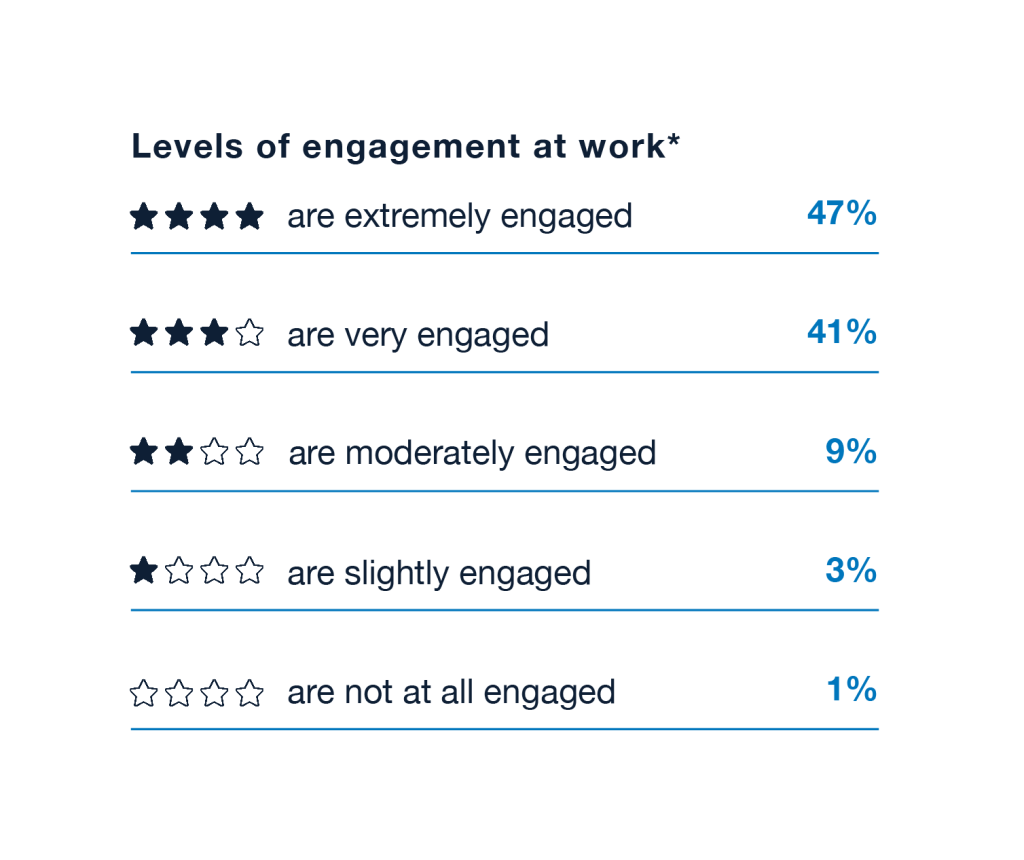
One way to shift employees from fear-based engagement to emotional investment in their work might be to offer more relevant professional development opportunities. More than 3 in 4 respondents (80%) said professional development opportunities increase their engagement. In addition, almost all respondents (93%) agree that they would feel more engaged at work if employers offered more relevant professional development opportunities.
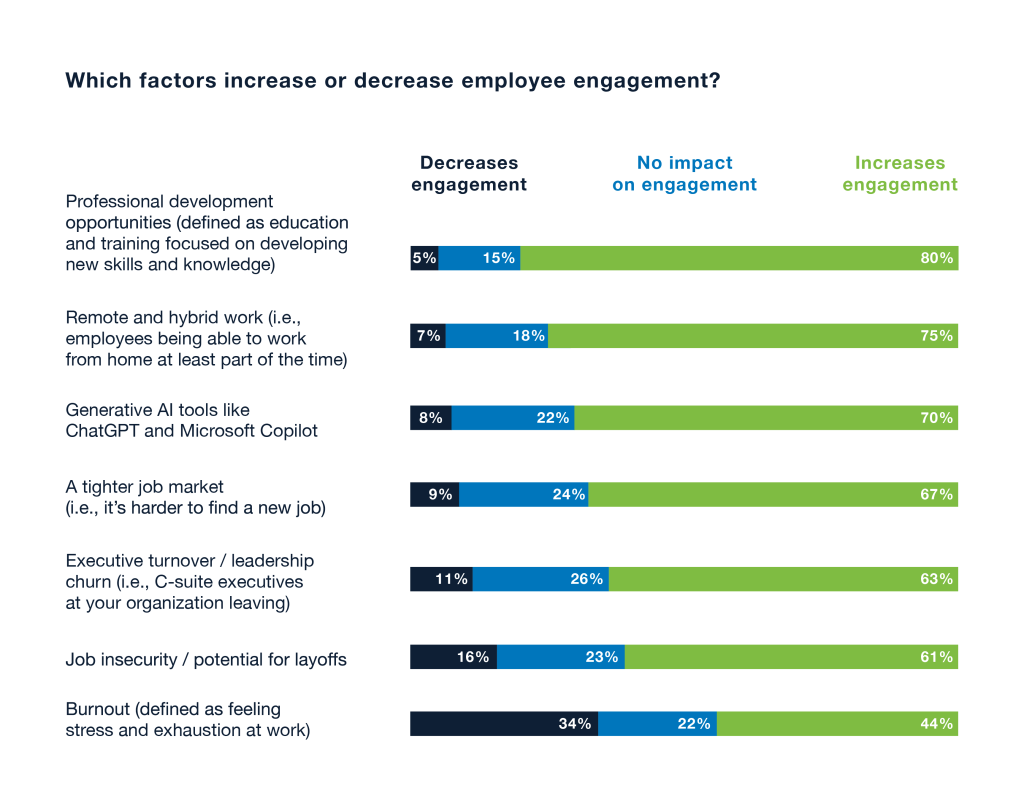
Remote & Hybrid Work Spotlight
Does in-office work boost engagement?
Remote and hybrid workers are less engaged than their in-office counterparts. 59% of respondents who work fully in person are extremely engaged — compared to 41% of hybrid respondents and 33% of remote respondents. However, 9 in 10 hybrid respondents also cite remote and hybrid work as a key driver of engagement, showing the importance of continuing to offer work flexibility. Leaders shouldn’t jump to return-to-office initiatives as a cure-all for engagement gaps, but instead focus on how to engage employees who aren’t physically present in the office.
Key Takeaway
Employee engagement is high — but not for the reasons employers might want. Some employees may feel compelled to stay engaged not out of enthusiasm or commitment, but because they are wary of the potential risks of leaving their jobs.
Bolstering professional development offerings can help boost engagement in a deeper way, building employees’ emotional investment in their work.
The Burnout Epidemic: Uneven Impacts Across Demographics
Despite high rates of engagement, employees also reported high rates of burnout. Defined as feeling mentally, physically, and/or emotionally exhausted and stressed at work, burnout remains a pervasive workplace issue. One in three employees (34%) say burnout reduces their engagement, and over 8 in 10 employees (82%) say they feel burnt out to some degree.
Younger generations are more likely to say they feel burnt out. Baby boomers on the verge of retirement might not feel as much pressure at work as Gen Zers new to the workforce who are still proving
themselves, or millennials who may be stepping into management or leadership roles for the first time.
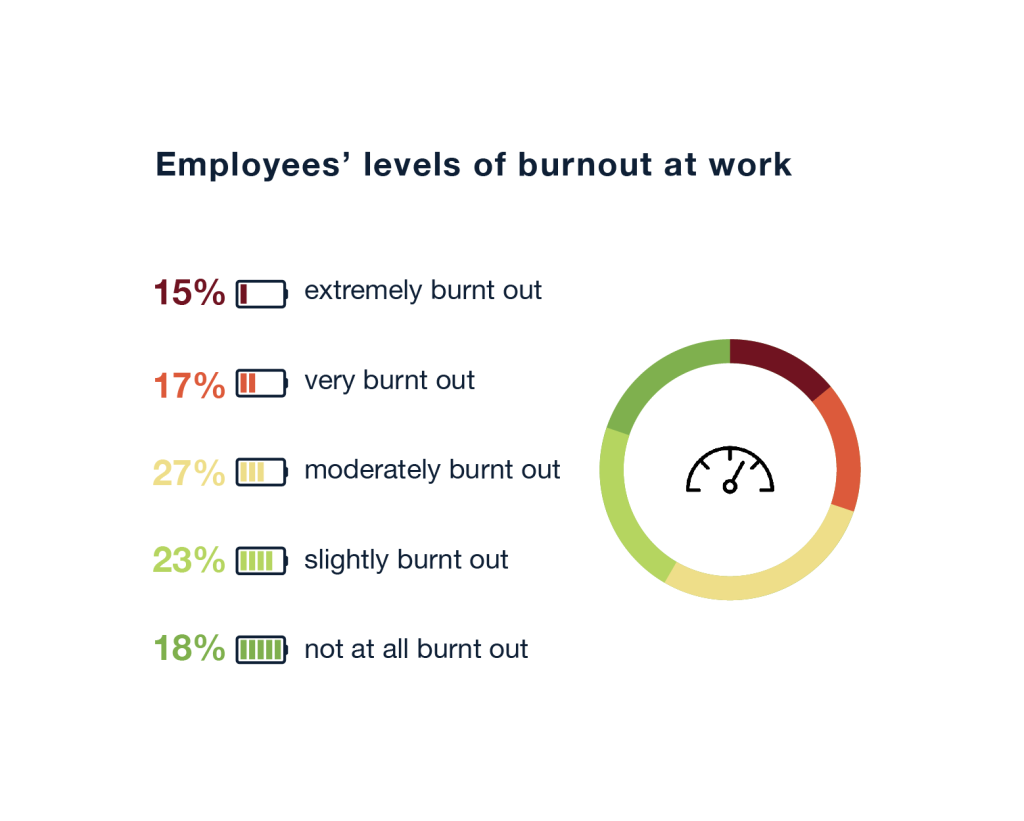
The drivers of burnout are similar across the board. Top contributors include working too many hours (58%), overwhelming workloads (35%), and difficulty balancing work obligations with personal/family life (34%). External factors can also exacerbate burnout. Sixty-one percent of employees agree that changes in their country’s political environment make them less engaged and more distracted at work. This could put employees at more risk for burnout in times of political turmoil or in important election years.
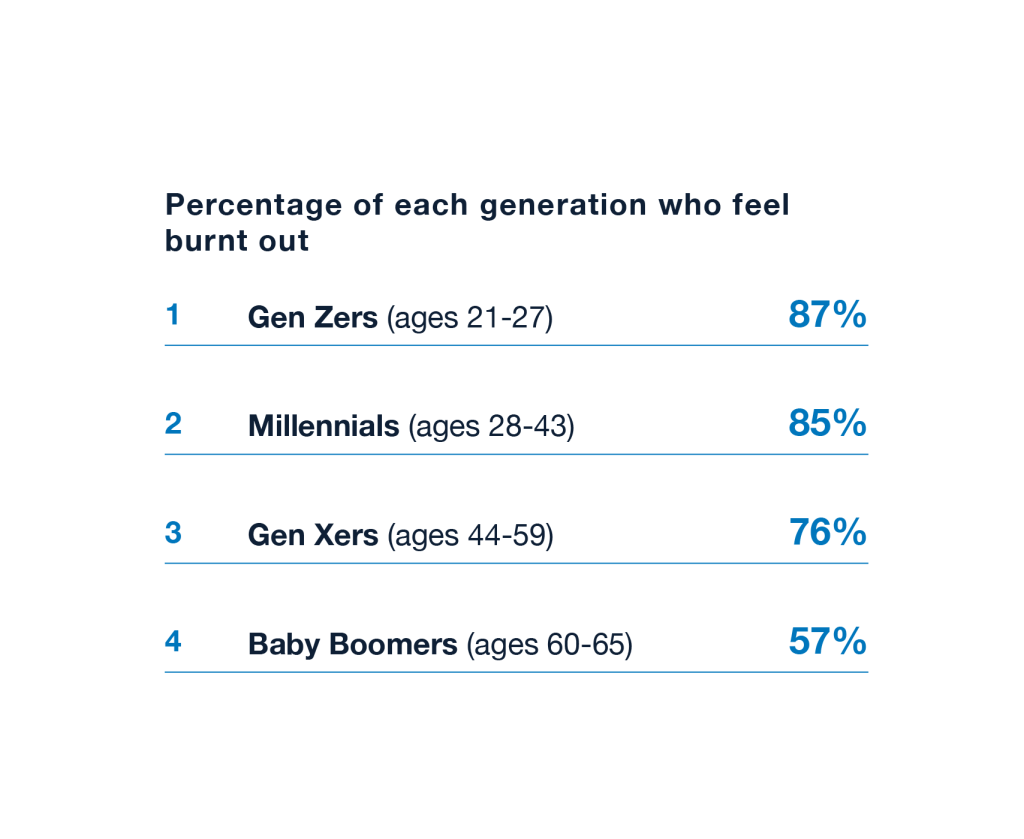
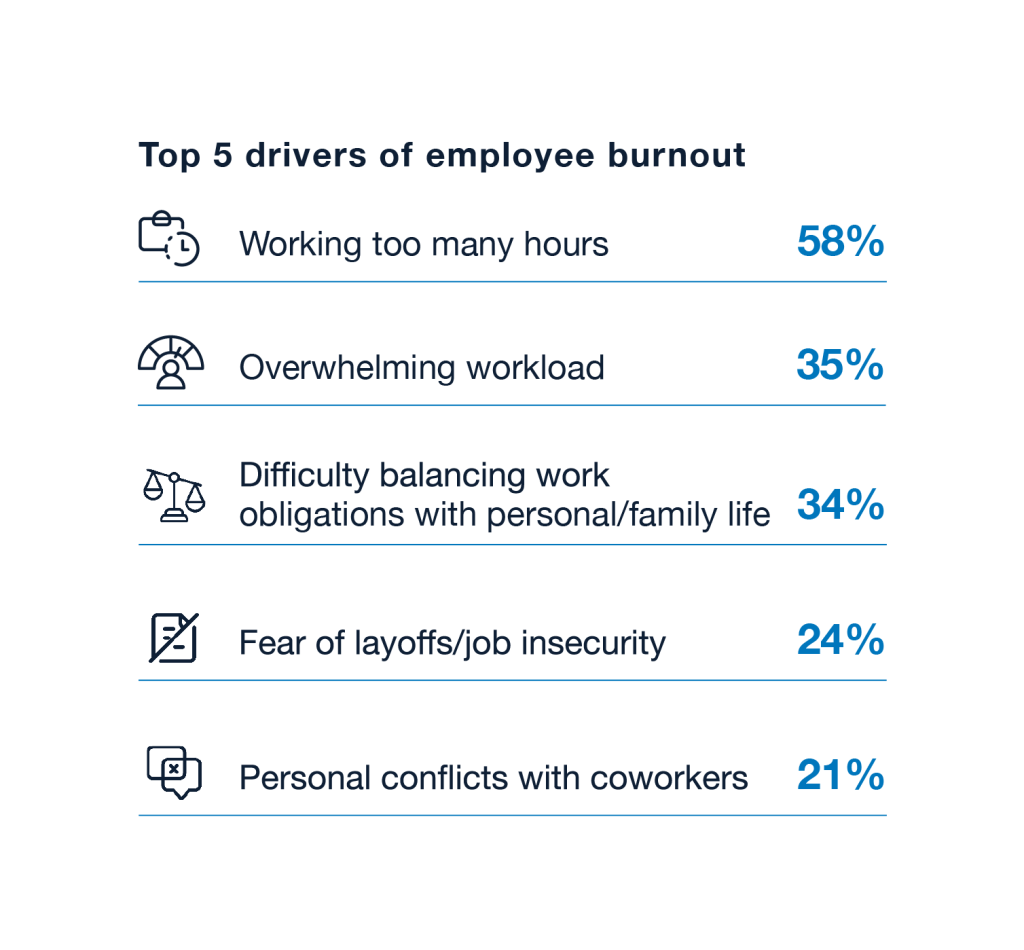
Global View
Burnout hits APAC harder
22% of APAC respondents feel extremely burnt out, compared to 13% of European respondents and 10% of North American respondents. 69% of APAC respondents say politics distracts them at work, compared to only 59% of European and 54% of North American respondents.
Key Takeaway
The top drivers of burnout — long hours, overwhelming workloads, and difficulty balancing work and personal life — reveal systemic issues within organizations. To better support
all employees, organizations must implement strategies to help manage workloads, promote work-life balance, and give employees space to process difficult external events.
Navigating AI’s Impact: From Productivity Gains to Job Security Concerns
The rise of generative AI tools like ChatGPT and Microsoft Copilot is sparking greater engagement and productivity, with 70% of respondents reporting these tools positively impact their engagement and 72% reporting a positive impact on productivity.
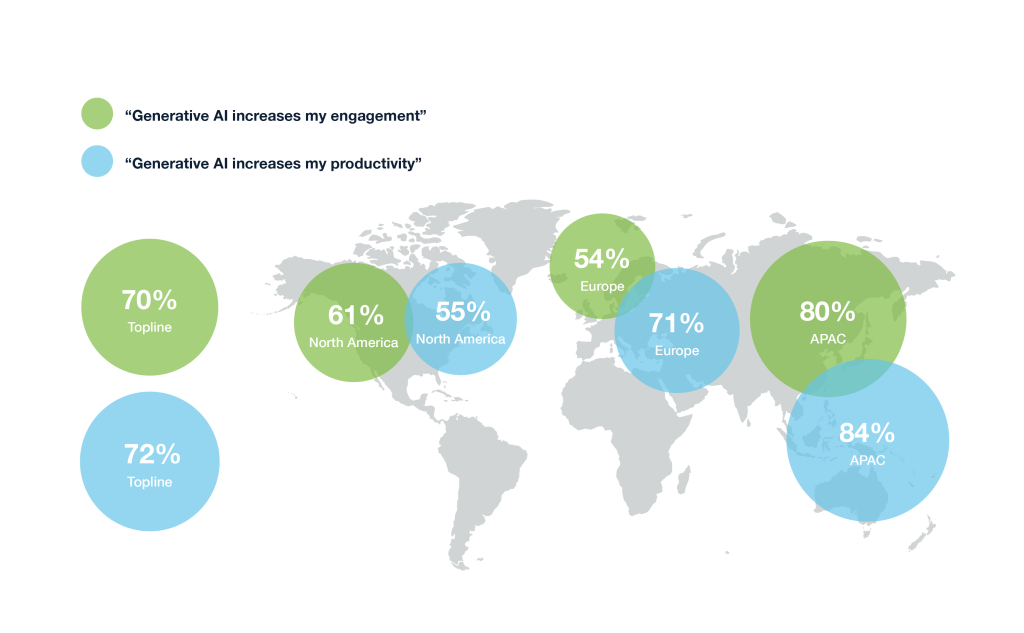
However, employees’ feelings about generative AI are more complicated. While most (52%) feel enthusiastic about using generative AI to improve their job productivity, a significant portion of respondents feel unsure (10%), neutral (21%), or skeptical (17%). In addition, more than half (51%) are concerned about the threat generative AI poses to job security.
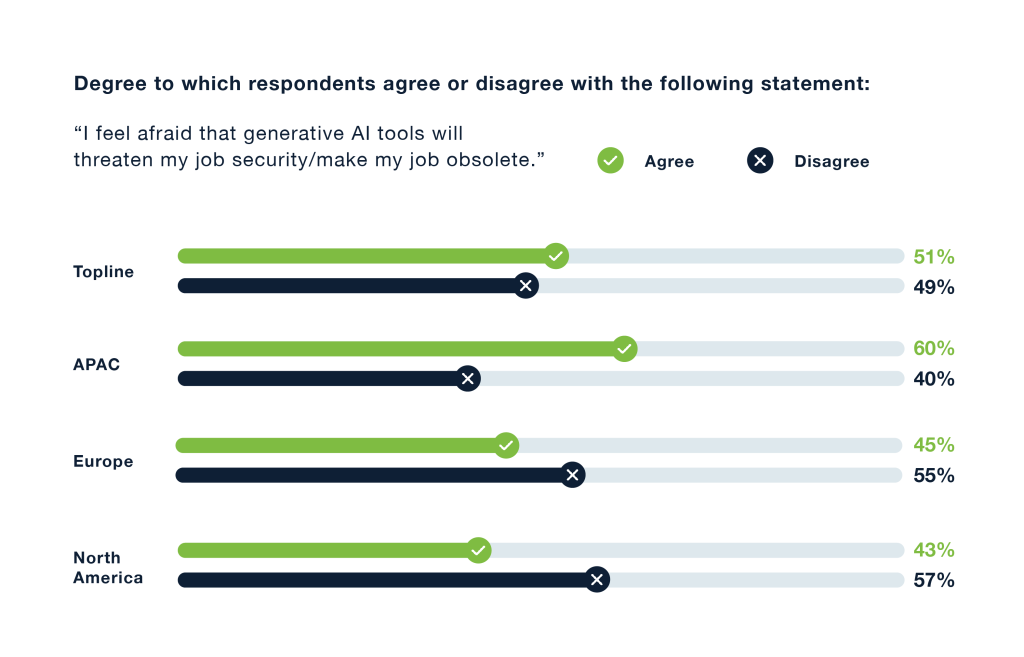
Global View
Mixed feelings about AI in Europe
Almost three-quarters of European respondents (71%) said generative AI increases their productivity, signaling embracing the new technology. However, only 54% said generative AI increases their engagement — lower than both APAC (80%) and North America (61%).
Key Takeaway
Nearly half of all respondents remain neutral, skeptical, or unsure about AI’s potential impact on productivity. That underscores the need for organizations to provide clear guidance and support to help employees navigate these tools — potentially an important focus for professional development.
Trust & Turnover: The Consequences of Leadership Changes in the Workplace
In the past year, half of respondents experienced the departure of a C-suite executive at their organization. Given that 74% of employees express trust in their senior leaders (43% deeply trust them and 31% somewhat trust them), it’s understandable that C-suite departures have an impact on 93% of employees.
Over half of respondents (55%) said the departure of a C-suite executive has made them question whether their organization’s mission is worth believing in or working for, and 52% said it created operational problems, like delays and confusion over ownership of projects.
However, new leadership can also be an opportunity to inspire employees with a refreshed vision or new direction for the company. Almost two-thirds of employees (63%) said executive turnover increases their engagement.
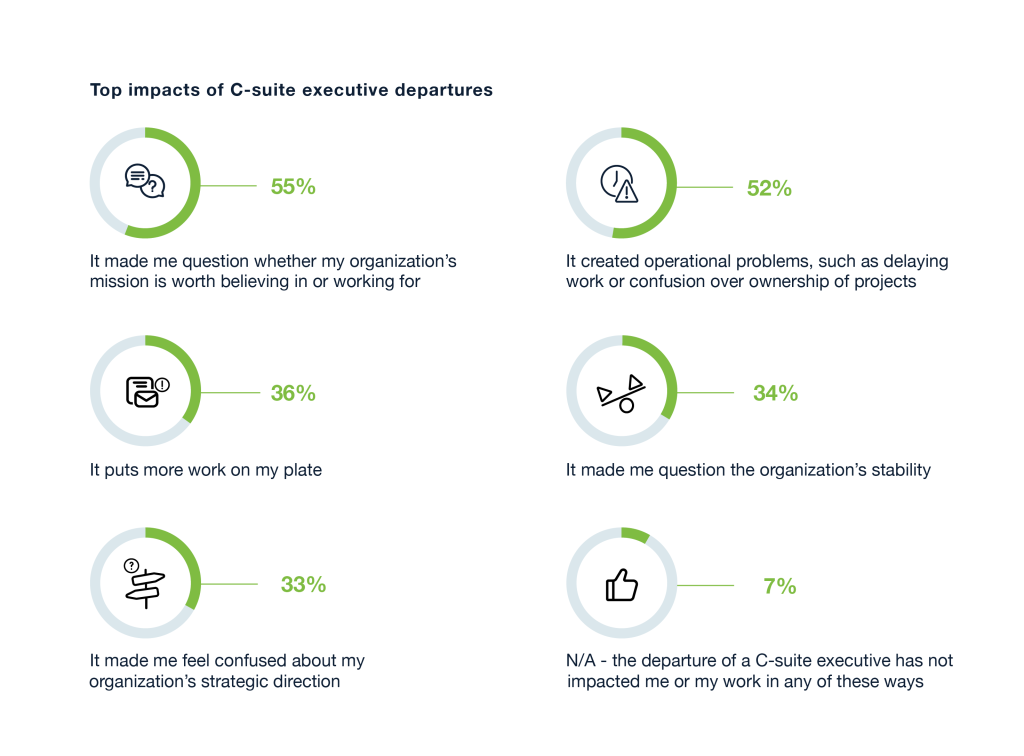
Key Takeaway
The departure of C-suite executives can disrupt employees’ trust and confidence. However, it doesn’t have to be that way. Organizations that approach leadership transitions carefully can maintain morale — and even take advantage of the opportunity to re-engage and inspire
employees.
When a new executive takes the reins, it’s vital that they present a clear vision for where they want to take the company, then take immediate steps to implement it. If they can make their first six months count, they will create momentum that will last the rest of their tenure.
Looking Ahead
The past few years have been tumultuous for employers, and 2025 is unlikely to be any different. In the U.S. specifically, employers will need to adjust to a new presidential administration and any accompanying regulatory shifts. Worldwide, economic uncertainty will continue to rattle financial markets. Long-term trends like generative AI and remote work will continue to evolve. Addressing these and other current trends
today will lay the groundwork for your organization’s future success.
Leading the Way in 2025
From what drives employee engagement and burnout to the impact of AI and executive turnover, get the information executives need to pave a path for success in 2025.
Methodology
DHR Global surveyed 1,500 white-collar, desk-based knowledge workers who are proficient in English and aged 21 or older. The respondents were evenly distributed across three geographic regions: 500 from North America (U.S. and Canada), 500 from Europe (Germany and the U.K.), and 500 from Asia (India, Hong Kong, and Singapore).
*Percentages do not add up to 100% due to rounding.
DHR Global
Always Connected.
DHR is a leading, privately-held provider of executive search, leadership consulting, and emerging leader search solutions in more than 50 markets spanning 22 countries. With expertise in more than 20 industries and functional areas, DHR pairs clients with resourceful consultants who have the most experience in their world. For 35 years, DHR has solved talent challenges by being connected, accountable, attentive, and prepared to hit the ground running to ensure clients have the best talent available.
